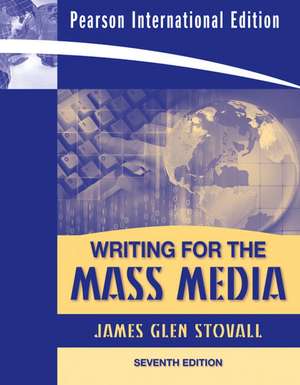Writing for the Mass Media: International Edition
Autor James G. Stovallen Limba Engleză Paperback – 18 dec 2008
Preț: 316.67 lei
Nou
Puncte Express: 475
Preț estimativ în valută:
60.61€ • 65.86$ • 50.95£
60.61€ • 65.86$ • 50.95£
Carte indisponibilă temporar
Doresc să fiu notificat când acest titlu va fi disponibil:
Se trimite...
Preluare comenzi: 021 569.72.76
Specificații
ISBN-13: 9780205724970
ISBN-10: 0205724973
Pagini: 384
Dimensiuni: 216 x 276 mm
Greutate: 0.78 kg
Ediția:7Nouă
Editura: Pearson Education
Colecția Pearson Education
Locul publicării:Upper Saddle River, United States
ISBN-10: 0205724973
Pagini: 384
Dimensiuni: 216 x 276 mm
Greutate: 0.78 kg
Ediția:7Nouă
Editura: Pearson Education
Colecția Pearson Education
Locul publicării:Upper Saddle River, United States
Cuprins
Table of Contents
Preface xi
Chapter 1: Sit Down and Write
Chapter 11: Writing Advertising Copy
Chapter 13: The Writer and the Law by Matthew Bunker
Appendix A Copy-Editing Symbols
Appendix B Grammar and Diagnostic Exams
Appendix C Problem Words and Phrases
Appendix D Advertising Copy Sheets
Glossary
Index
Preface xi
Chapter 1: Sit Down and Write
- What is Good Writing?
- Getting Ready to Write
- Basic Techniques
- Writing for the Mass Media
- Professionalism
- The Changing Media Environment
- And Finally . . .
- Grammar
- Sentences
- Parts of Speech
- Common Grammar Problems
- Punctuation
- Spelling
- Computer Aids
- Words, Words, Words
- Writing With Clarity
- Accuracy
- Clarity
- Brevity
- Journalistic Conventions
- Journalistic Style
- Stylebooks
- The Associated Press Stylebook
- Language Sensitivity
- Conclusion
- The News Culture
- Elements of News
- The Importance of Accuracy
- Deadlines
- Ethical Behavior
- The Reporting Method
- Sources of Information
- Personal sources
- Interviewing
- Observation
- Stores Sources of Information
- Writing by Example
- The Inverted Pyramid
- The Lead Paragraph
- Developing the Story
- Using Quotations
- Characteristics of News Stories
- Transitions
- Attribution
- Short Sentences, Short Paragraphs
- Third Person
- An Attitude for Accuracy
- Other Story Structures
- Types of News Stories
- Editing and Rewriting
- Writing Feature Stories
- Characteristics of Feature Writing
- Parts of a Feature Story
- The Challenge of Writing
- Characteristics of the Web
- Writing Characteristics and Techniques
- Forms of Writing
- Microcontent
- Weblogs
- A Full Arsenal
- Journalism Expanded and Accelerated
- Demands of the Audience
- Characteristics of Web Writing
- Backpack Journalism
- Lateral Reporting
- Web Packages
- Wanted for the Web: Writers and Editors
- Broadcast Style
- Broadcast Copy Preparation
- Television News Story Formats
- Television News Story Scripts
- Putting Together a Newscast
- Conclusion
Chapter 11: Writing Advertising Copy
- A Love-Hate Relationship
- The Field of Advertising
- Beginning the Process: Needs and Appeals
- The Audience
- The Product
- The Advertising Situation
- Copy Platforms
- Writing the Ad
- Elements of a Print Ad
- Writing Advertising for Broadcast
- Web Advertising
- Other Media
- Conclusion
- The Public Relations Process
- An Organization’s “Publics”
- The Work of the PR Practitioner
- Characteristics of the PR Practitioner
- Writing News Releases
- Video News Releases
- Letters
- Company Publications
- Oral Presentations
- Conclusion
Chapter 13: The Writer and the Law by Matthew Bunker
- The First Amendment
- Defamation
- The Plaintiff’s Case
- Affirmative Defenses
- Privacy
- Copyright and Trademark
- Advertising
- Broadcast Regulation
- Conclusion
Appendix A Copy-Editing Symbols
Appendix B Grammar and Diagnostic Exams
Appendix C Problem Words and Phrases
Appendix D Advertising Copy Sheets
Glossary
Index
Caracteristici
- A focus on becoming a professional writer (ch.1) increases the professional orientation of the book to prepare students more effectively for their future careers.
- An emphasis throughout the text on the four characteristics of media writing: accuracy, clarity, precision and efficiency.
- Simple, straightforward explanations of grammar, spelling, punctuation, and style rules that provide students with the basic foundation on which to build good writing skills.
- Abundant exercise material at the end of each chapter that enable students to practice the principles of good writing in a media environment.
- Exercises that deal with some of the most common writing problems, such as use of the comma and pronoun-antecedent agreement.
- Information on legal aspects that give students a complete picture of writing for publication in the media.
- Numerous examples of the concepts that provide students with models from which to learn.
Caracteristici noi
- Features a new chapter that emphasizes the techniques and thought processes students must use when writing in the media environment.
- Updates the chapter on the Web toinclude numerous innovative exercises that develop students’ writing skills, taking into account many of the structures and demands of the Web environment.
- Explains the concepts of lateral reporting and the importance of microcontent and the principles for creating it.
- Provides new examples of good writing, against which students are encouraged to model their own writing.
- Updates exercises found in many of the chapters, including those involving grammar and style, allowing students to put content into practice.
- Expands the glossary to provide students with easy access to definitions of terms used throughout the book.
- Offers an updated Instructor’s Manual, which includes additional material for lectures and discussions as well as additional exercise material.
